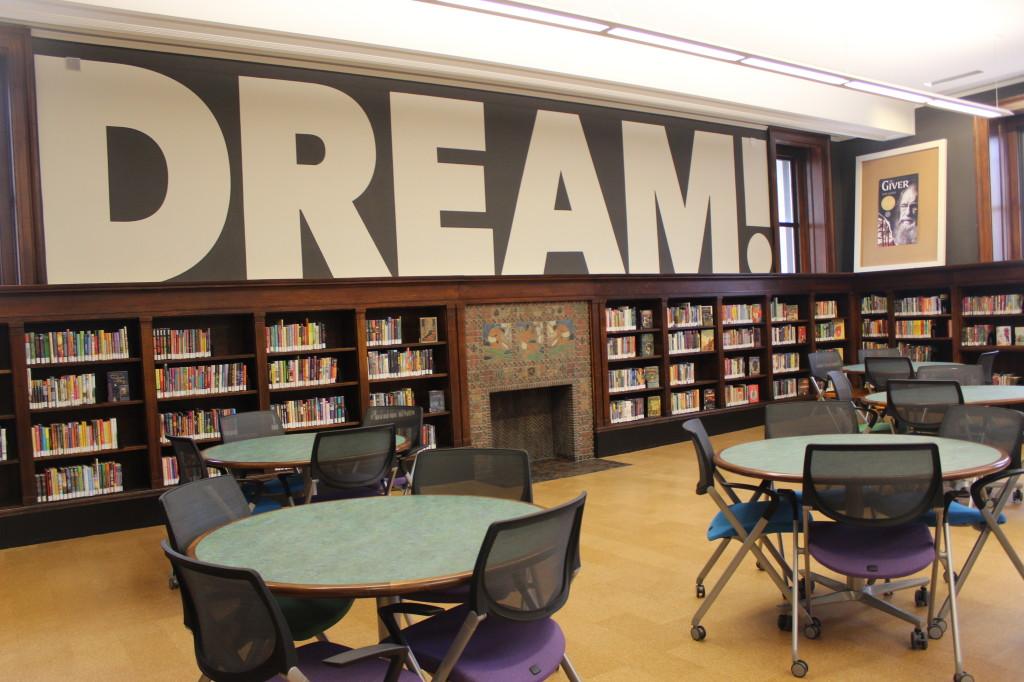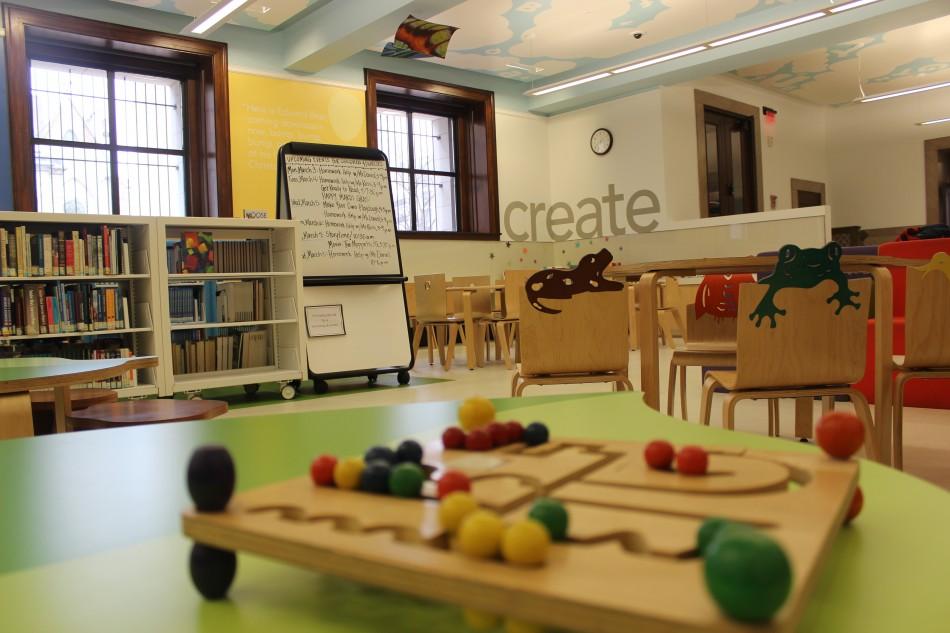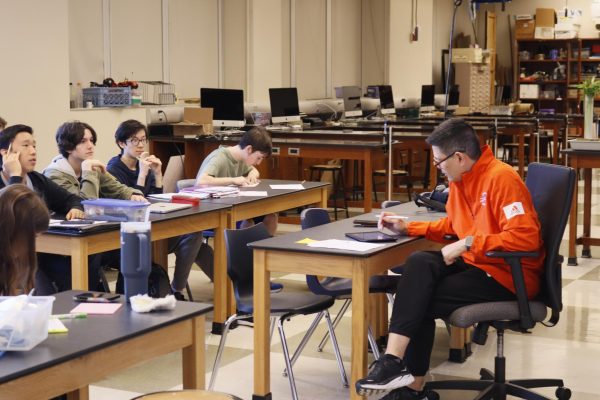Central Library Renovations

On the corner of Locust and Olive Street, the old and the new converge.
The medium of this phenomenon is the St. Louis Central Library, a towering building that rises from the main street in two sweeping sets of white stone stairs.
The library has always been a key fixture in St. Louis’s historical and architectural world.  However, after renovations completed in December 2012, Central Library has emerged as one of the city’s crowning glories.
Central Library’s multi-million dollar renovations were designed by the firm Cannon Design and architect George Z. Nikolajevich.
The restorations are a mix of sweeping, conspicuous changes and behind-the-scenes alterations.
One of the largest changes to the building was the removal of the seven stories of glass-floored stacks containing part of the library’s collections. The collections were dispersed into compact shelving throughout the facilities in order to make space for the granite atrium.
The library’s historic ceilings, which are unique from room to room, underwent careful restoration by artists and craftsmen.
Central Library’s renovations also sought to add environmentally-friendly changes to the facilities.
“We took out fluorescent lighting that had been added in the 1950s and put in LED lights, energy efficient lights and new chandeliers,†Brenda McDonald, the Director of Central Services, said.
The library also saw the arrival of several new rooms designed around further opening the library to public use and enjoyment. An auditorium with a capacity of 250 people was built in the basement, and an extensive children’s library emerged on the second floor.  This room features enormous, colorful panels with scenes from well-known children’s books such as The Giving Tree and Madeline.
A teen room sits on the same floor as the children’s room, with the words “Dream†and “Be†written across the walls in large block letters.
The Center for the Reader rests nearby, one of the library’s most impressive rooms.  Hundreds of books cover the red and white stacks, brown cushioned benches with frosted barriers provide seats for readers and quotes from books such as Kurt Vonnegut’s Slaughterhouse Five and Joseph Heller’s Catch-22 are embossed in white lettering on the ceiling.
Central Library’s historical significance commanded much of the attention of the architectural team throughout the remodelling process.
The main goal of the renovations, McDonald said, was “Bringing the library up to the twenty-first century but not harming the historical integrity of the building.â€
Remaining true to the original architecture proved to be an enormous task in itself, for the library was created by one of the nation’s then most prominent architects: Cass Gilbert.
Gilbert is most famous for his design of the New York Woolworth building and the United States Supreme Court building in Washington, D.C. Â He designed the Central Library as a building nested within a building. Â An oval building containing the Great Hall sits within a hollow rectangular building which makes up the outside facade of the library.
The architects and library staff’s first goal in the renovations was seamlessly blending the contemporary with the historical.  Black and white photographs from the library’s early days reveal this vision; while the interior of many rooms has progressed and evolved, much of the basic structure remains the same.
The enormous amount of work that went into the design, construction, and maintenance of the Central Library has been recognized, however, in appreciation that flowed in from across the globe.
“We get a lot of people who come here on vacation in St. Louis, and they make sure they see the library just like they see the History Museum and the zoo.  This summer we noted that we have people from other countries that have come through because they heard about it,†McDonald said.
Although there wasn’t a huge flux of visitors after the library reopened, McDonald has noted a steady increase in attendance, a promising fact.
“Some places see a huge increase at first, and then it drops and drops and drops.  Ours is steadily increasing, which is very reassuring … because it means people are coming back,†McDonald said.
The library has won several prestigious awards and recognitions from national organizations, the most recent being the 2014 Institute Honor Award for Architecture from the American Institute of Architects.
One of the greatest achievements of the renovations was its success in ensuring that the library is, above all things, a place for the citizens of St. Louis to convene, to connect and to learn. Â This objective appears throughout the new building.
First, much of the library that was once closed to the public has been refitted in order to increase access and usability, thus expanding the available space without moving beyond the library’s original walls.
“We took out office areas on the third floor and added that all into public service areas†McDonald said.
The library has also instituted several programs and events within its walls that further establish Central as a home for St. Louisans themselves as well as their literature. Â One such program that the library hosted was Launch Code, a non-profit organization which teaches participants basic computer programming code, a skill which then allows them to get jobs in computer technology.
“They were looking for a place where they could offer this twelve week course, so we set them up in our auditorium… We had about 3000 people in the library that day [of the program],†McDonald said.
Although not all of the visitors were attending for Launch Code, the number reflects the vast quantity of St. Louis citizens who have embraced the manifest opportunities offered to them by the new library.
Libraries play a unique role in communities across the world. Â They surpass the invocations to be sources merely of knowledge and information from which they were first born. Â Instead, libraries offer a blend of the cultural and the intellectual, the national and the local. Â It is this spirit of diverse nurturing that is embodied within the walls of the new Central Library and which makes it a beacon for the entire community of St. Louis.
At the bend in the granite staircases between the second and third floors, a brilliant stained glass tree stretches across the almost floor-to-ceiling window.
“Pax artes litterae,†it reads.
Peace, arts, literature.
A $50 or more donation includes a subscription to the Clayton High School Globe 2024-2025 print news magazine.
We will mail a copy of our issues to the recipients of your choice.
Your donation helps preserve the tangible experience of print journalism, ensuring that student voices reach our community and that student democracy thrives.

Gwyneth Henke joined the Globe during her sophomore year. She was the co-Feature and Review section editor during her junior year, and is the current co-editor in chief in her...






